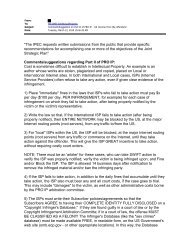We Energies Coal Combustion Products ... - The White House
We Energies Coal Combustion Products ... - The White House
We Energies Coal Combustion Products ... - The White House
Create successful ePaper yourself
Turn your PDF publications into a flip-book with our unique Google optimized e-Paper software.
ASR. <strong>The</strong> greater the proportion of Class C fly ash used in a mix, the greater<br />
the ASR control benefit.<br />
<strong>The</strong> concentration of soluble (available) alkali and not the total alkali content<br />
is critical for the reaction. Studies have shown that if the acid soluble alkalicontent<br />
is in excess of 5.73 lb./cu. yd., then it can cause cracking, provided<br />
that reactive aggregates are present. (This is approximately equivalent to 4.21<br />
lb./cu. yd. as water-soluble alkali.) For high-calcium Class C fly ash, the<br />
amount of alkali in the ash affects the effectiveness of expansion reduction.<br />
Another study by EPRI (22) indicated that for high-calcium (22.5% CaO)<br />
moderate-alkali (2.30% Na 2 Oeq) fly ash, the amount of fly ash required to<br />
control expansion due to ASR varies significantly from one aggregate to<br />
another. In the case of the extremely reactive aggregate, between 50%-60% of<br />
fly ash would be required to reduce expansion under the 0.10% level. For less<br />
reactive aggregate, a lower fly ash replacement level is required. For highcalcium<br />
(21.0% CaO) high-alkali (5.83 Na 2 Oeq) fly ash, it still contributed in<br />
reducing ASR expansion; however, an expansion higher than 0.10% level<br />
occurred. <strong>The</strong>refore, it is necessary to test the amount of alkali in the fly ash<br />
prior to incorporating it in the concrete to control ASR.<br />
<strong>The</strong> following aggregates and their mineralogical constituents are known to<br />
react with alkalis:<br />
• Silica materials - opal, chalcedony, tridymite and cristobalite<br />
• Zeolites, especially heulandite<br />
• Glassy to cryptocrystalline rhyolites, dacites, andesites and their tuffs<br />
• Certain phyllites<br />
Low-calcium (ASTM C618, Class F) fly ash is most effective in reducing<br />
expansion caused by alkali-silica reactions where the fly ash is used at a<br />
replacement level of approximately 20 to 30%. Once the replacement<br />
threshold has been reached, the reduction in expansive reaction for a given<br />
cement alkali level is dramatic. Additionally, the greater the proportion of<br />
cement replaced with Class F fly ash, the greater the ASR reduction. In some<br />
cases where silica fume, a very fine material that is high in reactive SiO 2 , is<br />
used in concrete for high strength, adding Class F or Class C fly ash to create<br />
a “ternary blend” can significantly reduce ASR susceptibility without<br />
diminishing high concrete performance. <strong>The</strong> actual reaction mechanism on<br />
alkali-aggregate reaction and the effect of fly ash is not fully understood today<br />
and will require more research to find a satisfactory explanation.<br />
Soundness of aggregates or the freedom from expansive cracking is one of the<br />
most important factors affecting the durability of concrete. At early ages,<br />
unloaded concrete cracks because of two reasons: thermal contraction and<br />
drying shrinkage. When concrete hardens under ambient temperature and<br />
humidity, it experiences both thermal and drying shrinkage strains.<br />
<strong>We</strong> <strong>Energies</strong> 52<br />
<strong>Coal</strong> <strong>Combustion</strong> <strong>Products</strong><br />
Utilization Handbook



